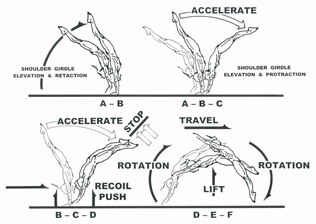Championship Gymnastics represents an entirely new approach to the study and understanding of gymnastics movement. It is the only textbook on the market that bridges the gap between theory and practice. Whether you are a gymnastics performer, teacher, coach, or even a judge, this textbook seamlessly weaves together the “science” of biomechanics with the “art” of gymnastics movement.
Rather than laboring on complex physics formulas, fundamental principles of biomechanics are clearly explained and presented in layman’s terms. Easy to read and expertly illustrated, readers are guided effortlessly through a “conceptualization process” for developing ideal movement patterns. The book includes 140 technical illustrations by noted artist and gymnastics coach Jim Stephenson. Gymnastics skills are described clearly and illustrated progressively to demonstrate that “similarities” in gymnastics movement patterns far outweigh “differences.” As a result, seemingly complex gymnastics skills are reduced to simple, easy-to-understand patterns of motion.
 Aside from the highly acclaimed Biomechanics of Women’s Gymnastics published in 1980 (authored by Dr. George), Championship Gymnastics is the only textbook in gymnastics that bridges the gap between theory and practice. Its breadth and depth of content are sufficiently complete to eclipse that of any competing gymnastics book in the world. Aside from the highly acclaimed Biomechanics of Women’s Gymnastics published in 1980 (authored by Dr. George), Championship Gymnastics is the only textbook in gymnastics that bridges the gap between theory and practice. Its breadth and depth of content are sufficiently complete to eclipse that of any competing gymnastics book in the world.
In Chapter 1, the concept of “ideal modeling” is introduced as a unique tool for shaping movement potential in gymnastics skills. Ten basic factors affecting success in gymnastics are introduced from the practical applications perspective. |
|
Chapter 2 presents five unique conceptual principles that can and should be employed to identify, refine and ultimately maximize gymnastics skill execution.
Chapter 3 (the handstand) demonstrates and emphasizes that proper mechanics and training of the handstand is the common denominator to successful learning of all gymnastics skills.
Chapters 4, 5 and 6 (swing, impact and rotation) systematically develop, progressively illustrate and clearly explain the 3 fundamental components that characterize all gymnastics movements from a “practical applications perspective.”
Chapter 7 (patterns of motion) covers the entire spectrum of core movement patterns in gymnastics. Innovative, yet easy-to-understand, concepts for mastering body shape inform readers of “what constitutes correct movement patterns and why.” And Chapter 8 (concepts of training) provides a clear and compelling training overview that explains “how to get there.” Rather than recommending specific training protocols, readers are guided through an understanding of the underlying principles for achieving high levels of flexibility and power. Armed with this perspective, gymnasts and coaches can design training programs that are specific to the unique needs of each individual performer.
The remaining Chapters 9, 10, 11 and 12, apply these movement concepts to each of the four Olympic events for women (floor exercise, balance beam, vault, and uneven bars). Each chapter carefully explains and accurately illustrates critical movement components that separate the champion from the would-be champion. |

